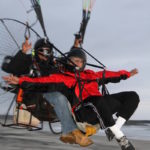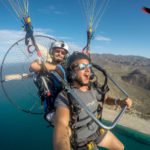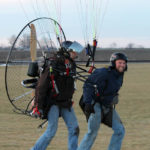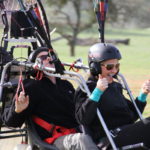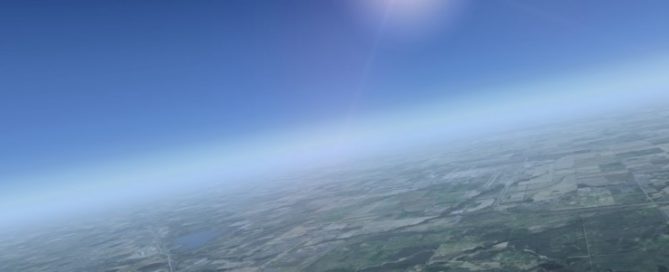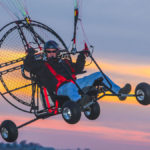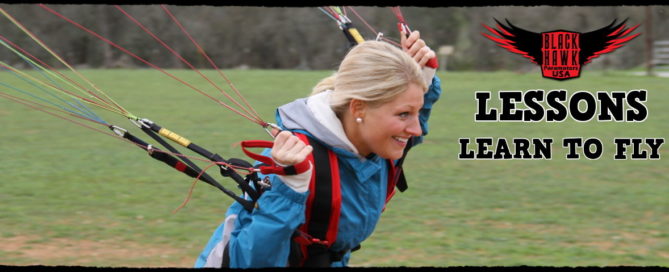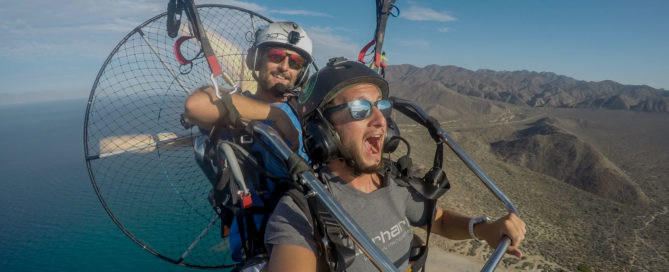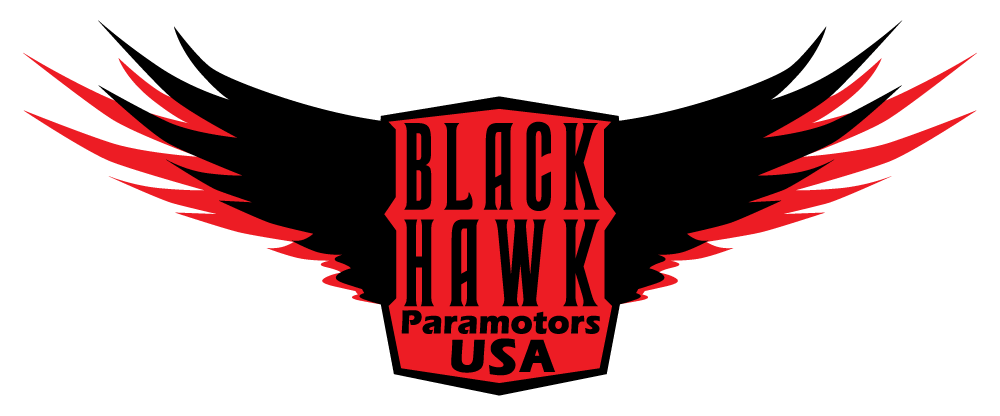
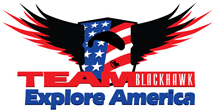
Here are a few of the most common questions we get about the sport of Powered Paragliding. This is a great place to start if you are new to the sport! If you have a question that isn’t posted here, just give BlackHawk Paramotors USA a call. We love helping people realize their dream of personal flight!
1-833-PPG-FLYR (774-3597)
THIS VIDEO IS A GREAT PLACE TO START:
(Click Video Above to Watch)
Total unit weight for most Foot-Launch Paramotors can range from 45-75 lbs, depending on the size of motor and amount of fuel. Multiple straps & attachment points on the harness distribute the pilot’s body weight evenly – similar to how a hiking backpack functions. This keeps the motor weight very manageable for most people. Keep in mind that the pilot only needs to support this weight for a brief moment during takeoff. Once they are airborne, the weight is burdened by the Paraglider. Accessories like reserve parachutes, helmets, or communication systems can also add additional weight and should be considered. Weight concerns mostly apply to those flying Foot-Launch Paramotors. Those flying Paramotor Quads obviously don’t have support the weight of the machine, making it less of a concern.
On average, beginner gliders have a cruising speed of 18-25 MPH. Skilled pilots can achieve much greater speeds by incorporating speed-bar systems, flying a smaller-sized glider, flying an advanced glider with Reflex Technology, or flying with the wind. In general, if you want to fly fast, buy an airplane! If you are looking for a low-and-slow way to explore the world from above, you’ve come to the right place! Keep in mind that there is a fine line between performance and safety. Gliders which are smaller, faster, or utilize more advanced flying configurations (like speed-bars) can often have less passive safety features than standard gliders. Always check with your Certified Flight Instructor prior to purchasing a new glider to MAKE SURE it coincides with your level of skill.
Most Paramotors utilize 2-stroke motors, with a fuel-to-oil mix. We always recommend using premium unleaded fuel (ethanol free if possible), and high-quality synthetic 2-stroke motor oil. Always refer to your engine manual or manufacturer for the exact fuel-to-oil mix. Many European Paramotors require the use of “aviation fuel,” which can be very expensive and hard to come by. If a Paramotor engine is designed and built properly, it should easily run on high-octane auto fuel. You should be able to purchase fuel anywhere, instead of having to locate an airport.
It is technically ILLEGAL in the United States to fly tandem in a Powered Paraglider. That being said, people frequently ask “Why are companies selling them if they are illegal in the US?” The answer is simple: Powered Paragliding is a global industry, and there are many countries where it is totally legal to fly a Tandem Paramotor. Many people have set up successful Tandem businesses, especially in tourist-rich locations. Tandem LowBoy II Paramotor Quads can be found on BlackHawk’s website for this very reason. There are very few regulations in this sport, and this just happens to be one of them. We are regulated by part 103 of the Federal Aviation Regulations.
NOTE: As of 2019, the USPPA (United States Powered Paragliding Association) has been able to provide some Pilots with “Tandem exemptions” – allowing them to fly Tandem IF specific requirements are met. If this is something you are interested in, please contact the USPPA or BlackHawk Paramotors for more information: 833-PPG-FLYR.
BlackHawk TANDEM Adventure Videos:
Of course! Most machines are specifically designed to break down for transport. Some will even fit into a large suitcase, or the trunk of your car! This makes traveling with them a breeze. Typically, Paramotor cages break down into multiple sections, the propeller can be easily removed, harnesses detach, and gliders can be folded down to a very compact size. This alone appeals to so many people who don’t have the room to store or transport an airplane. Many pilots take their Paramotors with them when traveling abroad due to their ease of transport. There are also many pilots who keep their motor with them at all times in the case they pass by a spot worth exploring. For pilots who don’t want to disassemble their machine each time, there are now several companies making racks which allow the Paramotor to be mounted to the back of a small car. Larger units like Paramotor Quads are commonly transported in the back of a truck. Even smaller-bed trucks will work with many of the motors out there. Most Paramotor platforms allow for the easy removal of axels, and cage pieces can be broken down. For those who have a small car and still desire a Paramotor with a Quad, small gardening trailers can easily transport the unit.

(THREE BlackHawk Paramotors easily fit into this truck)
A Paramotor is the most affordable personal aircraft out there. BlackHawk Paramotors USA are the ONLY manufacturer selling COMPLETE Paramotor Package Deals for under $8k which INCLUDE THE GLIDER. They basically cost less than what a quad or motorcycle would, and just imagine the potential of what you could do with your own flying machine! The possibilities are endless! Imported Paramotors (which most other brands are) can cost thousands more than domestically produced machines. Most of the prices of imported machines DO NOT INCLUDE a glider or any flight accessories. Another concern is availability of parts. Pilots don’t want to wait weeks for a simple part to arrive from overseas. That being said, your money and time will go a lot farther with a domestic manufacturer who offers package deals. One last thing to consider is the fact that Powered Paragliding is a weight sensitive sport. If you are a heavier pilot, you may need a larger motor or glider. If you live in a place like Colorado and launch from 7,000 feet regularly, you may need a different glider or motor to handle those demands. Higher elevations equates to “thinner air” or less “lift.” For an exact price quote or equipment recommendations, simply call (209) 786-7899.

On average, schools charge anywhere from $1200-$2500 for a 3-7 days of lessons. As with many things, you get what you pay for, and considering the training is what will keep you safe, shortcuts should not be taken here. Many people get excited when they discover this sport and they seek out the cheapest or closest Instructor to them. DO YOUR RESEARCH when choosing a school. Your life could very well depend on it. An easy way to make sure you are in good hands is to call an actual manufacturer of Powered Paragliding equipment and have them recommend an Instructor to you. You can also contact the USPPA to see if the Instructor holds a rating or has continued their education as a pilot over the years.
Paramotor Lessons:
On average, pilots can expect to get 45-60 minutes flight PER GALLON of gas. With a standard 3.5 gallon tank, one could fly anywhere from 2-4 hours. This of course depends on factors like throttle use, headwind speed, payload, size of engine, fuel efficiency, glide-ratio, and flying-style. Many pilots enjoy climbing up to a high altitude, shutting the motor off, and utilizing the thermals to fly for hours. Once they get back down to a low altitude, they can reach back, start up the motor, and do it all over again! That being said, you could stay airborne all day if conditions were optimal!
XC Paramotor Adventure Flights:
You can legally fly up to (under) 18,000 feet in a Powered Paraglider! It’s extremely rare for pilots to climb to such altitudes. Special adjustments, skills, and equipment (like an oxygen tank) would be required, and climbing to such elevations can put unnecessary strain on the motor. Not to mention, it can get quite cold up there! Most pilots fly from a few feet off the ground, to a couple thousand feet. As mentioned before, this sport is all about “low and slow.”
Absolutely! Many pilots out there have back issues, bad knees, or other joint problems which can limit mobility. Fortunately, they can take advantage of flying a Paramotor mounted to a Quad or wheeled platform. BlackHawk Paramotors USA is even offering FREE BASIC MODIFICATIONS to their machines to accommodate those with disabilities or special needs. Recently, a paraplegic man named Russel Metlitzky of California became a Paramotor Pilot. Russel was paralyzed from the chest down in his mid 20’s due to a tragic motorcycle accident. This didn’t stop him from following his dream of personal flight. With some basic modifications to his Paramotor, Russel is able to enjoy this sport like anyone else.
Paraplegic Man Learns to Fly a Paramotor:
AGE: There are many pilots in their 70’s and up who fly quite regularly. That being said, there isn’t an age cap on this sport. There are also young teens who fly with their parents. It really comes down to common sense… If you can’t drive a car safely, you should probably not be flying any type of aircraft. If there is any question, just ask a Certified Flight Instructor or Dealer if this sport is right for you.
WEIGHT: There are no pilot weight restrictions in this sport. The only weight regulated is the total weight of the actual Paramotor. That being said, any machine being sold by a manufacturer as a “Powered Paraglider” or “Paramotor” will meet the weight exemption requirements. This is a “weight sensitive sport” and the power-to-weight ratio we are seeing from recent technology is astounding! Companies like BlackHawk Paramotors are producing motors which can take up to a 600 lb. payload!
Hardly any! Many pilots will pull their motor out of the garage and takeoff right there from their yard! You don’t need a formal runway for Powered Paragliding. On average, Foot-Launch pilots can be airborne by running ONLY 10-50 feet. Many factors can effect takeoff distances like wind conditions, wind direction, type or size of glider, size of motor, pilot weight, and especially a pilot’s level of skill. For Quad Paramotor Flight, most pilots are airborne within 30-125 feet.
Much less distance is needed for landing. Foot-Launch Paramotor pilots can touch down, literally take a couple small steps, and be completely grounded. For Quads, the pilot can touch-down and come to a complete stop within 10-50 feet of travel. This again depends on conditions and skill-level. Even though it doesn’t take much room to takeoff or land, the rate of climb needs to be taken into consideration. If there are trees, power lines, or other obstacles surrounding the field you are taking off from, you may need additional room to “climb out.” Check with your Certified Flight Instructor or Manufacturer for approximate climb-out rates for your specific Paramotor configuration.
Example of Paramotor Takeoff & Landing:
It doesn’t get easier! There are only 4 inputs. You have up, down, left, and right. That’s it! The throttle controls how fast you go up or down, and the glider has two handles or “toggles” which direct the left-right steering. There is no clutch, gauges, signals, or anything else to worry about. I guess you could say “it’s much easier than driving a stick-shift car” once you get the hang of controlling the glider.
Yes… In fact, it’s the safest form of personal aviation bar-none. You are basically “flying a parachute.” People frequently ask “what happens if the motor dies,” and then catch themselves, saying “oh yeah, it’s a parachute! You just glide down.” Efficient gliders (like a Velocity Elektra for example) have a phenomenal “glide ratio” of 9.4:1. This means the glider will travel 9.4 feet forward, for every 1 foot down. If the motor shuts off, this will give the pilot plenty of time to locate an alternate landing site. For comparison, and to get an idea of how efficient these “Paragliders” are, standard modern “parachutes” have glide ratios of only 3:1! Beginner Gliders are designed to stay extremely pressurized, they are very forgiving to the pilot’s input, and have the natural tendency to fly straight by themselves.
In addition to the many passive-safety features on a Paramotor, pilots also fly with reserve parachutes, flotation devices, helmets, communication radios, and a basic tool kit. Aside from having the proper equipment, what keeps people safe in this sport is completing a professional training course from a CERTIFIED Instructor. You should NEVER attempt to teach yourself how to operate a Paramotor, even if you have a pilot’s license. This cannot be emphasized enough! This form of aviation is much different from any other type out there, and requires specific technique.
No. They are an interchangeable word, referring to the same type of flying machine. However, as mentioned above, there are two different styles of Paramotors… “Foot launch” units and “Quads” or “Trikes.”
- “Foot Launch” Paramotor
- “Quad” Paramotor
No… There is no license needed whatsoever to become a Paramotor Pilot! There are also NO insurance requirements, NO annual inspections, and NO hanger fees! This alone saves aviation enthusiasts thousands of dollars. You won’t find a more affordable way to have your very own personal flying machine.
CAUTION: Not needing a license has it’s benefits, however, no license means no regulating body. Unfortunately, anyone can open up a flight school, claim to be a expert, and start teaching people how to fly. To address this very concern, several of the industry’s TOP experts got together to create “The United States Powered Paragliding Association or USPPA. To this day, the USPPA is a non-profit organization, ran by volunteers, and remains the most recognized organization in the industry. This organization has created an exceptional quality control system through progressive pilot ratings systems, their thorough training syllabus for USPPA Certified Instructors to follow, and their open line of forum-based communication.
Proper training is what will keep you safe in this sport. That being said, it’s highly recommended that you have the actual Paramotor manufacturer recommend a training facility to you. Don’t go for “the guy down the street” offering lessons because it’s close or convenient. Watch out for Instructors who talk negatively about organizations designed to promote safety in the sport. These are commonly Instructors who have “burned their bridges” or have been kicked out of these organizations due to their behavior. The USPPA documents incidents and issues pilots have experienced. That being said, if you are concerned about the reputation of a specific Dealer or Instructor, CLICK HERE to contact the USPPA. Take your time in locating a certified, experienced, and knowledgeable instructor. To talk to an industry expert and start your adventure today, call (209) 786-7899.
On average, it takes most people 3-5 days to learn how to operate a Quad safely, and approximately 5-7 days to learn Foot-Launch Paramotor flight. Companies like BlackHawk Paramotors USA have National Training Centers throughout the United States, and have instructed thousands of people over the years. To learn more about Powered Paragliding lessons, or to locate an authorized National Training Center near you, PLEASE CLICK HERE.
Powered Paragliding is the safest, cheapest, and most convenient way to have your own personal flying machine. You don’t even need a pilot’s license, and it takes less than a week to learn how to fly one! To sum it up, it’s basically a “parachute with a backpack motor” or a “motorized version of Paragliding.” There are two different types of Powered Paragliders or “Paramotors.” The most common is called a “Foot-Launch” unit, where the pilot wears a backpack-style 2-stroke motor, and has to physically run to become airborne. The second type is called a “Quad” or “Trike” unit, where the motor is mounted to a go-kart-style platform with wheels. To decide which type of unit is appropriate for you, it’s best that you talk to an expert. BlackHawk Paramotors USA is one of the largest manufacturers of Powered Paragliding equipment in the world, and their staff is always available to help. Many factors like weight, age, physical ability, takeoff elevation, and flying-style determine which gear is best suited for an individual. Most people are familiar with Parasailing, Sky-Diving, Base Jumping, or Wing Suits. Powered Paragliding however, is still a foreign concept to many people and you don’t have to be a “thrill-seeker” to enjoy it. Powered Paragliding is all about “low and slow leisure flight.” The best part is ANYONE can do it!
- “Quad” Paramotor



